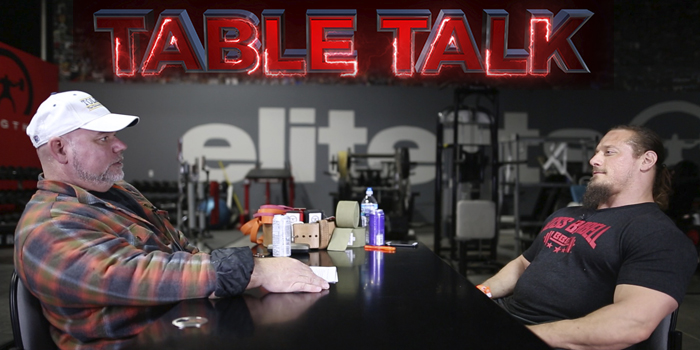
In the previous Table Talk, Dan Green shared the current structure of his diet and use of safety squat bar for squats and good mornings. In this video, he and Dave now turn their attention to training and Dan's current setup. Beginning at the general level, Dan shares that, far out from a competition, he structures his training in phases with general goals. For the most part, however, his training is conjugated. There's a degree of linear periodization where he moves from lighter and less specific training to heavier and more specific training as he prepares for a meet, but he doesn't work with blocks intended to directly bring up specific strength aspects.
The only time he really trains in "blocks" is when he's not preparing for a competition. For instance, one block he did twice last year was four weeks of pause deadlifts. The basic training cycle for that was to simply progress each week by increased intensity and reduced volume:
- Week 1: 6x5 with 60%
- Week 2: 5x5 with 65%
- Week 3: 5x4 with 70%
- Week 4: 4x4 with 75%
The purpose of this block was to address lower back weakness, so this four-week wave allowed him to put a lot of weight on his back for a lot of time under tension. After these four weeks, Dan had to do somewhat of a deload workout because of the fatigue it had put on him, but after the deload, he started hitting PRs. Dan explains that these smaller blocks are helpful for bringing up weak points but are not critical to his overall plan because they occur before a meet training cycle.
On the lift-specific level, Dan uses a heavy-light-medium approach to training. With this approach, each week he does a heavy day with moderate volume, a moderately heavy day with low volume, and a light day with high volume. For instance, for deadlift Dan trains his back three times each week. Friday he deadlifts heavy with moderate volume, Monday he squats and does stiff-leg deadlifts or Romanian deadlifts as a supplemental movement, and on Tuesday he does a lighter bodybuilder-style back day with high volume of movements such as rows and pull-ups.
WATCH: Table Talk with Dan Green — Current Nutrition Strategy
Though this is Dan's current approach, Dave asks a follow-up question to learn what type of methodology Dan used before he found this approach that works for him. Dan responds that when he first started training for powerlifting, he did a lot of what he knew from following Louie Simmons and Westside training, including speed days and max effort days with extra high-rep days thrown in. One of his biggest takeaways from this type of training was that training his upper back almost every single workout, up to six times each week, was really effective.
This also taught him the lesson about prioritization to improve weak points. Dan says there are two ways to achieve this. The first approach is to put an effective, beneficial exercise as the first exercise on its own day (which Dan does for front squats). The second approach is to train that weak point with more volume and frequency, possibly even every day (which Dan does for his upper back).
Dave's reaction to this is to observe that Dan's answers seem to suggest that he started with a rough global template to his training, spent a lot of time trying different stuff to find what worked and what didn't work, and has very gradually over an extended period of time refined his own plan. This, in Dan's opinion, is what is necessary to succeed in powerlifting; any lifter has to be able to find out what works for them and not be afraid to do something that goes against what they might've read from another lifter. Everyone wants to find a perfect program, but that perfect program is only found by making a lot of mistakes, having a lot of success, and paying attention to what works and what adjustments need to be made. This happens both on a micro level (adjusting training on the daily basis when you feel awful) and on the macro level (changing the details of your 12-week plan from one meet to the next).
Dan's mindset is that there's a balance between going based on feel and sticking straight to a plan. Either extreme is going to lead to failure, which means you have to find a good middle point that enables you to follow a general plan but not be afraid to change things to suit how your body responds. For example, Dan has learned through experience that when he does heavy front squats (doubles and triples), he doesn't get what he needs out of it. But if he does sets of five to eight reps, he continually makes good progress; form stays consistent, he gets better as he goes, and he builds muscle mass. Furthermore, he's found he can only push this lift for six weeks because by the seventh or eighth week he starts to regress. These lessons give him a very solid set of guidelines to follow. The only way he developed these guidelines was by trying multiple approaches and taking note of what worked.









